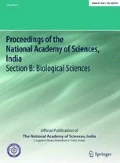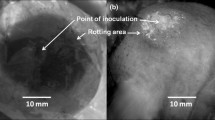Abstract
The present work was aimed at the determination of distribution of lactic acid bacteria on aerial surfaces of pomegranate, and evaluation of the antifungal potential for their possible use as biocontrol agent. Maximum population of lactic acid bacteria was detected on flowers of Bhagwa and Ganesh variety, although the count was higher in Bhagwa (P < 0.05). The population of lactic acid bacteria on different sample types was significant (P < 0.05) during April and October season, and the count was always higher in October season. Potent antifungal isolates were identified by phenotypic characters (Gram positive card kit) and partial 16S rDNA sequencing as Lactobacillus brevis, Enterococcus faecium, Lactococcus lactis ssp. cremoris and Lactococcus lactis ssp. lactis. Of the 200 lactic acid bacteria isolates, 124 were antagonistic towards Fusarium graminearum as determined by agar overlay technique. Out of these, 26 were able to retain the antifungal activity after long term storage of 12 months at 4 °C. Thus, pomegranate plant is an excellent source for diverse antifungal lactic acid bacteria.




Similar content being viewed by others
References
Franz D, Supo O, Schillinger U, Hozapfel WH (1998) Plantaricin D, a bacteriocin produced by Lactobacillus plantarum BFE 905 from ready to eat salad. Lett Appl Microbiol 26:232–234
O’Sullivan L, Ross RP, Hill C (2002) Potential of bacteriocins producing lactic acid bacteria for improvements in food safety. Biochimie 84:593–604
Carr FJ, Chill D, Maida N (2002) The lactic acid bacteria: a literature. Crit Rev Microbiol 28:281–370
Sathe SJ, Nawani NN, Dhakephalkar PK, Kapadnis BP (2007) Antifungal lactic acid bacteria with potential to prolong shelf-life of fresh vegetables. J Appl Microbiol 103:2622–2628
Magnusson J, Strom K, Roos S, Sjogren J, Schnurer J (2003) Broad and complex antifungal activity among environmental isolates of lactic acid bacteria. FEMS Microbiol Lett 219:129–135
Laitila A, Alakomi H-L, Mattila-Sandholm T, Haikara A (2002) Antifungal activities of two Lactobacillus plantarum strains against Fusarium molds in vitro and in malting of barley. J Appl Microbiol 93:566–576
Strom K, Sjogren J, Broberg A, Schnurer J (2002) Lactobacillus plantarum MiLAB 393 produces the antifungal cyclic dipeptides cyclo (l-phe-l-pro) and cyclo (l-phe-trans-4-oh-Lpro) and 3-phenyllactic acid. Appl Environ Microbiol 68:4322–4327
Rouse S, Harnett D, Vaughan A, van Sinderen D (2008) Lactic acid bacteria with potential to eliminate fungal spoilage in foods. J Appl Microbiol 104:915–923
Chen YS, Yanagida F, Shinohara T (2005) Isolation and identification of lactic acid bacteria from soil using an enrichment procedure. Lett Appl Microbiol 40:195–200
Contreras BG, DeVuyst L, Devreese B, Busanyova K, Raymaeckers J, Bosman F, Sablon E, Vandamme EJ (1997) Isolation, purification and amino acid sequence of lactobin A, one of the two bacteriocins produced by Lactobacillus amylovorus LMG P-13139. Appl Environ Microbiol 63:13–20
Corsetti A, Settanni L, Van Sinderen D (2004) Characterization of bacteriocin-like inhibitory substances (BLIS) from sourdough lactic acid bacteria and evaluation of their in vitro and in situ activity. J Appl Microbiol 96:521–534
Stiles ME (1996) Biopreservation by lactic acid bacteria. Antonie Van Leeuwenhoek 70:331–345
Batish VK, Roy U, Lal R, Grover S (1997) Antifungal attributes of lactic acid bacteria: a review. Crit Rev Biotechnol 17:209–225
Lavermicocca P, Valerio F, Evidente A, Lazzaron S, Corsetti A, Gobbetti M (2000) Purification and characterization of novel antifungal compounds from the sourdough Lactobacillus plantarum strain 21B. Appl Environ Microbiol 66:4084–4090
Leslie SB, Israeli E, Lighthart B, Crowe JH, Crowe LM (1995) Trehalose and sucrose protect both membranes and proteins in intact bacteria during drying. Appl Environ Microbiol 61:3592–3597
Magnusson J, Schnurer J (2001) Lactobacillus coryniformis subsp. coryniformis strain Si3 produces a broad spectrum proteinaceous antifungal compound. Appl Environ Microbiol 67:1–5
Maharashtra Pomegranate Growers Association, Pune, Maharashtra, India. http://www.pomegranateindia.org Accessed 10 Mar 2012
Rangaswami G (2000) Diseases of crop plants of India, 4th edn. Prentice hall of India, New Delhi, pp 378–379
Sheikh MK (2006) The pomegranate. International Book Distributing Co., Lucknow
Tziros GT, Lagopodi AL, Tzavella-Klonari K (2008) Alternaria alternata fruit rot of pomegranate (Punica granatum) in Greece. Plant Pathol 57:379
Tziros GT, Tzavella-Klonari K (2008) Pomegranate fruit rot caused by Coniella granati confirmed in Greece. Plant Pathol 57:783
Compant S, Duffy B, Nowak J, Clement C (2005) Use of plant growth promoting bacteria for biocontrol of plant diseases: principles, mechanism of action, and future prospects: minireview. Appl Environ Microbiol 71:4951–4959
Whipps JM (2001) Microbial interactions and biocontrol in rhizosphere. J Exp Bot 52:487–511
Suslow TV, Schroth MN, Isaka M (1982) Application of a rapid method for Gram differentiation of plant pathogenic and saprophytic bacteria without staining. Phytopathology 72:917–918
Axelsson L (2004) Lactic acid bacteria: classification and physiology. In: Salminen S, von Wright A, Ouwehand A (eds) Lactic acid bacteria, microbiology and functional aspects. Marcel Dekker Inc., New York, pp 1–66
Nawani NN, Kapadnis BP, Das AD, Rao AS, Mahajan SK (2002) Purification and characterization of a thermophilic and acidophilic chitinase from Microbispora sp. V2. J Appl Microbiol 93:965–975
Trias R, Baneras L, Montesinos E, Badosa E (2008) Lactic acid bacteria from fresh fruit and vegetables as biocontrol agents of phytopathogenic bacteria and fungi. Int Microbiol 11:231–236
Ongeng D, Devlieghere F, Debevere J, Coosemans J, Ryckeboer J (2006) The efficacy of electrolysed oxidizing water for inactivating spoilage microorganisms in process water and on minimally processed vegetables. Int J Food Microbiol 109:187–197
Roy U, Batish VK, Grover S, Neelakantan S (1996) Production of antifungal substance by Lactococcus lactis subsp. lactis CHD-28.3. Int J Food Microbiol 32:27–34
Hassan YI, Bullerman LB (2008) Antifungal activity of Lactobacillus paracasei ssp. tolerans isolated from a sourdough bread culture. Int J Food Microbiol 121:112–115
Sjogren J, Magnusson J, Broberg A, Schnurer J, Kenne L (2003) Antifungal 3-hydroxy fatty acids from Lactobacillus plantarum MiLAB 14. Appl Environ Microbiol 69:7554–7557
Author information
Authors and Affiliations
Corresponding author
Rights and permissions
About this article
Cite this article
Gajbhiye, M., Prakash, D., Jagdale, S. et al. Pomegranate Borne Fungicidal Lactic Acid Bacteria and their Biodiversity. Proc. Natl. Acad. Sci., India, Sect. B Biol. Sci. 82, 413–419 (2012). https://doi.org/10.1007/s40011-012-0055-8
Received:
Revised:
Accepted:
Published:
Issue Date:
DOI: https://doi.org/10.1007/s40011-012-0055-8




